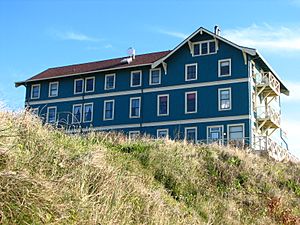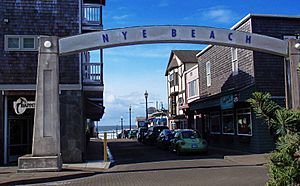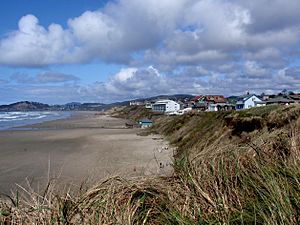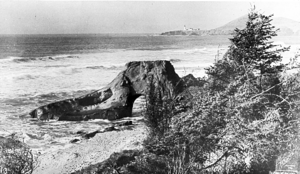Nye Beach facts for kids
Nye Beach is a cool neighborhood in Newport, Oregon. It's right on the Pacific Ocean. This area has been a popular vacation spot since the late 1800s. Nye Beach is home to many art and writing groups. You can find Newport's main art and performance centers here too. The beach is great for finding cool things in tide pools, looking for shells, or trying out surfing. People also come here to fly kites, take photos, and make art!
Changing Coastline of Nye Beach
In the early 1800s, Nye Beach looked a bit different. To the south, there was a big rocky area called Jump-off Joe. This rock stuck out into the ocean and made it hard to walk along the beach.
The Story of Jump-off Joe
Over time, the ocean waves and weather slowly wore away Jump-off Joe. This is called coastal erosion. By the mid-1900s, the rock had formed an arch. Eventually, it crumbled completely. Now, only a few scattered rocks show where it once stood.
Without Jump-off Joe, Nye Beach now connects directly to Agate Beach State Recreation Site to the north. After Jump-off Joe disappeared, other smaller rocks appeared and then also crumbled. One of these was called "Slipper Rock." It looked a lot like Jump-off Joe, even having an arch, before it too was worn away by the sea.
Landslides and Erosion at Nye Beach
Nye Beach has seen some big changes due to landslides. In 1942, a large landslide happened near where Jump-off Joe used to be. About 15 acres (6 hectares) of land slid into the ocean. This caused several houses to fall down. More homes were damaged by the ocean washing away the land beneath them.
Later, in 1980, a new building project also collapsed near the "Slipper Rock" area. You can still see parts of these events today. Broken concrete walls and foundations can be seen from the ocean.
Jump-off Joe was made of sandstone, which wears away faster than other rocks. Nearby, Yaquina Head is made of stronger rocks like basalt. That's why Yaquina Head has stayed mostly the same, while Jump-off Joe disappeared.
History of Nye Beach
In the early 1800s, the land that became Nye Beach was part of a large Coast Indian Reservation. By 1865, the U.S. government opened the area for people to claim land through homesteading.
Early Days and John Nye
A man named John Nye claimed land near Nye Creek in 1865. At that time, it was mostly wilderness. Most visitors to Newport went to the Yaquina Bay area. Nye Beach was hard to reach because it had no roads and was surrounded by cliffs. But Nye Creek had carved a path through the cliffs to the ocean. This spot became the center of Nye Beach, known as "the Turnaround."
By the 1890s, people started coming to Nye Creek for summer vacations. In 1891, a wooden walkway was built to connect Nye Creek to the bay. Soon, this walkway became a road. Summer visitors gathered on the beach for concerts and other fun events.
Nye Beach as a Creative Hub
Nye Beach became a popular place for artists, writers, and scientists. This started in 1896 with a teachers' conference. In 1897, a group of college people built an auditorium near Nye Creek. They held summer classes in "Science, Music, Mirth, Art and Religion" until 1902. Even though the classes stopped, Nye Beach became known as a place for creative and smart people. The auditorium was taken down in 1910, and its wood was likely used for other buildings.

By the late 1800s, many summer cottages were built. People also camped in tents along Nye Creek. By 1902, shops, hotels, and fun attractions started to appear. The Cliff House Hotel, built in 1913, is still there today. It became the Hotel Gilmore in 1921. Then, in 1986, it changed into the Sylvia Beach Hotel, a special place for readers and writers.
Bathing and Entertainment
In 1901, a bathhouse was built at the Nye Creek beach entrance. It had changing rooms for people who wanted to swim in the ocean. In 1902, a doctor named Henry J. Minthorn opened ocean-water baths. He practiced medicine in Newport until 1922.
In 1911, the bathhouse was replaced by a large indoor swimming pool called a natatorium. This building offered heated seawater baths and sunbathing rooms. It was very popular for many years. It burned down in 1922 but was quickly rebuilt. The new natatorium was even fancier, with a domed roof. Besides the pool, it had a dance hall, a movie theater, bowling, and roller skating.
Eventually, the natatorium became less popular and fell apart. It was torn down, and the area became a picnic spot and parking lot at the Nye Beach Turnaround. Today, the only part left is a building that used to be public restrooms. It is now the Yaquina Art Gallery.
Growth and Transportation
By the mid-1920s, Newport had paved streets. Many vacation cottages were built. Visitors came by train from Albany, then by ferryboat and bus. They could stay at many different cottages and hotels.
Early travel to Newport depended on trains to Yaquina City. From there, people took a ferry to Yaquina Bay. People hoped the railway would reach Newport, but it never did. In 1928, train service to Yaquina City stopped. This might have slowed tourism for a bit. But by 1930, new highways were being built, making the area much easier to reach.
Construction of the "Roosevelt" Highway (now Coast Highway) started in 1919. It was planned to run along the entire Oregon Coast. Soon, Newport had a highway connection to Lincoln City in the north and Waldport in the south. However, ferries were still needed to cross Yaquina Bay and Alsea Bay.
Another new road, the Salmon River Highway (now Highway 18), connected inland areas to the coast. By 1936, bridges were built across major rivers like the Rogue, Alsea, Yaquina, Coos, and Umpqua. This meant cars could easily travel along the entire Oregon Coast.
Nye Beach in Modern Times
Throughout the 1940s, Nye Beach kept developing its unique style. During World War II, the beach was patrolled by blimps and local citizens. They guarded the coast from possible attacks. Many special homes were built in the 1940s, creating what is known as the "Nye Beach style." Some of these homes, like the Grand Victorian, are still standing today.
In the 1980s, Nye Beach was a bit rougher. But by the 2000s, it became a more organized community. It now has its own business group, modern buildings, and cultural events. In 2007, a big building called Archway Place was built. It has fancy shops and expensive apartments. Other similar projects followed. Coast Street, a busy shopping area, was updated with cool paving stones. Two cement arches were built over the entrance to the Turnaround.
Not many of the old historic cottages are left. Some are now rentals or shops. Many were replaced by apartments in the 1980s. Others were replaced by modern hotels like the Elizabeth Street Inn and the Inn at Nye Beach. The Inn at Nye Beach, built in 2010, was designed to be very eco-friendly. It uses solar panels to create electricity.
Today, the Performing Arts Center (built 1988) and the Visual Arts Center (built 1985) are next to the Yaquina Art Gallery. Nye Beach has many unique shops, art galleries, restaurants, and cafes. It also has important services like an animal hospital and an ambulance service.
People of Nye Beach
John Nye
John Nye was born in Ohio in 1832. In 1859, he traveled west. He reached Corvallis, Oregon, in 1860. After working different jobs, he came to the Oregon coast.
In 1865, he claimed land where Nye Creek is. He built a cabin there. After living there for 19 months, he had met the requirements for his land claim. Then he went to Indiana, married Olive Kist, and returned to Oregon. When he officially mapped his coastal property, he named Olive Street after his wife. In 1874, the Nyes moved to another farm east of town. They farmed, raised eight children, and lived there for the rest of their lives.
John Nye sold his Nye Creek land to a developer named Sam Irvin in 1880. Sam Irvin helped promote tourism in Newport in the 1880s.
Ed Seidler
In 1901, Ed Seidler built the first bathhouse at Nye Creek. This is now the Nye Beach Turnaround.
John Minthorn
In 1902, John Minthorn, a doctor, opened a health center in Nye Creek. It offered hot seawater baths. Minthorn was from Newberg. He was the uncle of Herbert Hoover, who later became a U.S. President. Minthorn raised Hoover as his son from age 10. Dr. Minthorn first visited Newport in the summers but later became a full-time resident. The Minthorn House is one of the historic homes still standing in Nye Beach today.
Donald A. Davis
Donald A. Davis was the Newport City Manager from 1962 to 1992. The Don Davis park in Nye Beach is named after him to honor his great work for the city.




